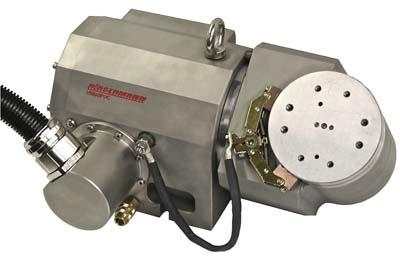
Carl Hirschmann Inc. offers stainless steel, submersible 1-axis and 2-axis rotary indexing tables used in the manufacture of complex workpieces for wire, vertical, small-hole EDM, and milling applications, which include medical, power turbine, aeronautical engineering, gear manufacturing and R&D. The A/B-axis is equipped with a 100mm-dia. faceplate with mounting holes for fixtures and the company's manual clampers, or as an option, integrated air connections for pneumatic clampers.
The A/B axes is programmed and driven by the Hirschmann controller H1625.AC2 which allows automatic sequencing by M code (24V) to the machine tool control. The NC program is generated via the keyboard or by downloading from a PC or machine control by using an RS232-interface. Direction integration to certain machine tools that eliminate the need for the H1625.AC2 will be available in the near future. Features of the H100ABR.NC, as well as dimensional drawings (CAD) that include the 2-Axis controller H1625.2AC are available upon request.
Contact Details
Related Glossary Terms
- electrical-discharge machining ( EDM)
electrical-discharge machining ( EDM)
Process that vaporizes conductive materials by controlled application of pulsed electrical current that flows between a workpiece and electrode (tool) in a dielectric fluid. Permits machining shapes to tight accuracies without the internal stresses conventional machining often generates. Useful in diemaking.
- gang cutting ( milling)
gang cutting ( milling)
Machining with several cutters mounted on a single arbor, generally for simultaneous cutting.
- milling
milling
Machining operation in which metal or other material is removed by applying power to a rotating cutter. In vertical milling, the cutting tool is mounted vertically on the spindle. In horizontal milling, the cutting tool is mounted horizontally, either directly on the spindle or on an arbor. Horizontal milling is further broken down into conventional milling, where the cutter rotates opposite the direction of feed, or “up” into the workpiece; and climb milling, where the cutter rotates in the direction of feed, or “down” into the workpiece. Milling operations include plane or surface milling, endmilling, facemilling, angle milling, form milling and profiling.
- numerical control ( NC)
numerical control ( NC)
Any controlled equipment that allows an operator to program its movement by entering a series of coded numbers and symbols. See CNC, computer numerical control; DNC, direct numerical control.
